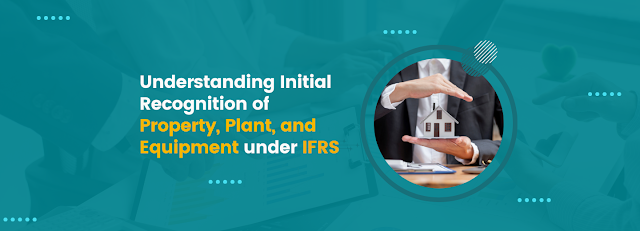Understanding Initial Recognition of Property, Plant, and Equipment under IFRS
Property, plant, and equipment (PPE) play a significant role in the financial reporting of companies, representing tangible assets used in operations. Initial recognition of PPE is a crucial step in accounting for these assets, governed by IAS 16: Property Plant & Equipment. In this blog, we delve into the process of initial recognition of PPE as per the provisions of IAS 16, outlining key principles and considerations in a concise manner.
Definition of Property, Plant, and Equipment:
Property,
plant, and equipment encompass tangible assets held for use in production,
supply of goods or services, rental to others, or administrative purposes.
These assets are expected to generate economic benefits over multiple periods
and are distinct from inventory or financial instruments. Examples include
land, buildings, machinery, and vehicles.
Criteria for Recognition:
According
to IAS 16, PPE should be recognized in the financial statements when:
It is
probable that future economic benefits associated with the asset will flow to
the entity.
The cost
of the asset can be reliably measured.
Measurement of Initial Recognition:
The
initial recognition of PPE involves determining the cost of the asset, which
includes all expenditures directly attributable to bringing the asset to its
intended condition and location for use. This may include purchase price, delivery
costs, installation charges, and initial testing expenses.
Components of Cost:
Initially
a PPE will be recognized at cost. There are three elements of cost:
·
Purchase Price: The amount paid to acquire the
asset, including import duties and non-refundable purchase taxes, after
deducting trade discounts and rebates.
·
Directly Attributable Costs: Costs directly associated with
bringing the asset to the location or condition necessary for it be used as
intended by the management. Such as transportation and installation.
·
Initial Estimates: Any initial estimates of
decommissioning, dismantling, or restoration costs that are included in the
asset's cost.
Subsequent Recognition:
Once
initially recognized, PPE subsequently can be carried at cost or a revaluation
model. PPE is measured at cost less accumulated IAS 16 depreciation and any
accumulated impairment losses. Depreciation is calculated systematically over
the asset's useful life to reflect its consumption of economic benefits.
Disclosure
Requirements:
Entities
are required to disclose significant accounting policies related to PPE,
including the measurement basis used (e.g., cost model or revaluation model),
IAS 16 depreciation methods, useful lives, and residual values. Additionally,
disclosures about the carrying amount, accumulated depreciation, and any
revaluation adjustments are necessary.
Conclusion:
The
initial recognition of property, plant, and equipment is a fundamental aspect
of financial reporting under IAS 16. By adhering to the criteria outlined in
IAS 16 and accurately measuring the cost of PPE, entities can provide
transparent and reliable information about their tangible assets to
stakeholders. Understanding the principles of initial recognition ensures
compliance with accounting standards and facilitates informed decision-making
regarding capital investments and asset management.
Are you interested to know more about
the Finance Industry? Check the finance
courses available on one of the leading online learning
platforms, MindCypress.
Resource: https://www.mindcypress.com/blogs/finance-accounting/understanding-initial-recognition-of-property-plant-and-equipment-under-ifrs





Comments
Post a Comment